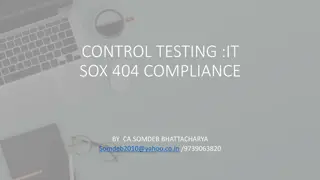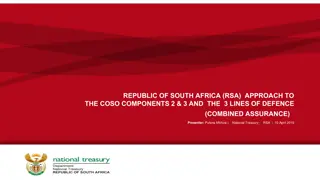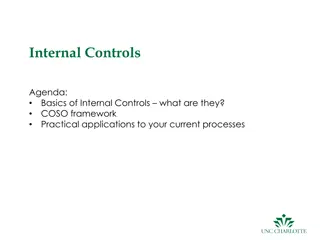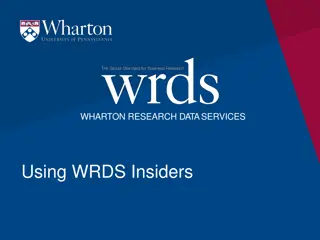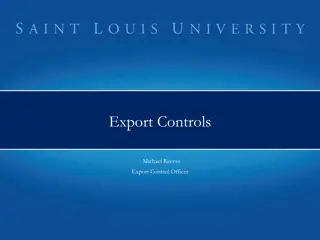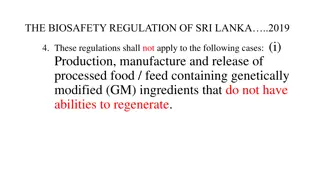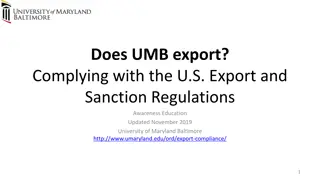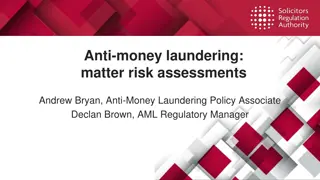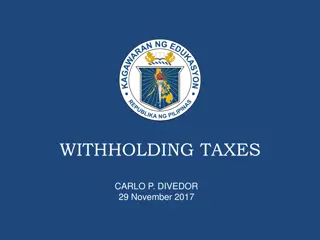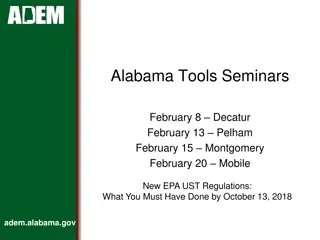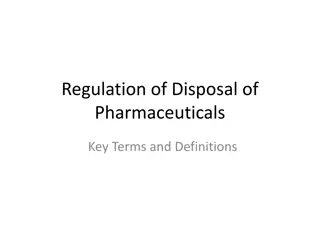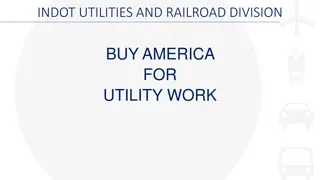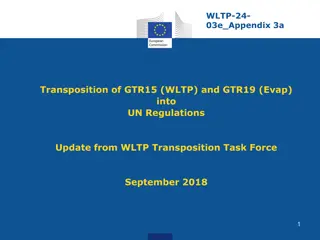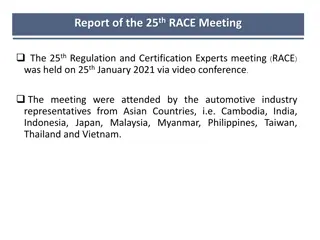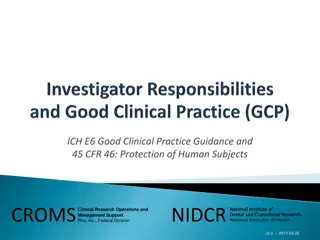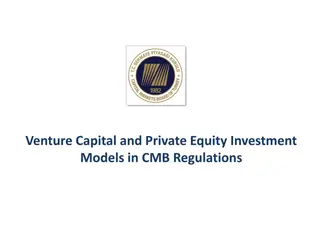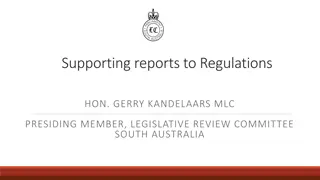Understanding FDICIA, SOX, and COSO Regulations
This content explores the significance of COSO, FDICIA, and SOX regulations for boards, audit committees, and management teams in financial institutions. It covers the distinctions, compliance requirements, and key considerations related to internal controls over financial reporting, ERM programs, and information security roles. Essential concepts such as asset size thresholds, compliance responsibilities, and regulatory expectations are discussed within the context of these regulatory frameworks.
Download Presentation

Please find below an Image/Link to download the presentation.
The content on the website is provided AS IS for your information and personal use only. It may not be sold, licensed, or shared on other websites without obtaining consent from the author. Download presentation by click this link. If you encounter any issues during the download, it is possible that the publisher has removed the file from their server.
E N D
Presentation Transcript
COSO / FDICIA / SOX 101 FOR BOARDS, AUDIT COMMITTEES, MANAGEMENT TEAMS DAVID B. SIDON, CPA - KEVIN W. NUNES NAVIS PARTNERS LLC, D/B/A THE NAVIS GROUP
$1 Billion not just about COSO / FDICIA Two other thoughts before we explore COSO / FDICIA As you approach / eclipse $1 billion in assets . 1. Regulatory expectations with respect to formalization of an ERM program emerge COSO s 2017 ERM Guidance provides a great ERM program template 2. Regulatory expectation emerges that Info Security Officer (ISO) become a stand-alone independent position (not reporting to Tech)
Internal Controls over Financial Reporting Introduction to COSO / FDICIA / SOX Banks with assets exceeding $1 billion are subject to FDICIA integrity Stocks banks with a market cap exceeding $75 million are subject to Sarbanes-Oxley {SOX} COSO is the best practice methodology for compliance Internal controls over financial reporting {ICFR} is the operational / transactional focus COSO s 17 principles guide the cultural aspects of compliance 2 components : operational / transactional integrity and cultural / corporate governance integrity Let s explore the acronyms and the details
FDICIA vs. SOX vs. COSOimportant distinctions FDICIA FDICIA (the FDIC Improvement Act of 1991, as amended) in part, requires banks with assets exceeding $1 billion to assert that an internal control methodology is in place to assure the integrity of the annual audited financial statements, as well as the four quarterly Call Reports. Who asserts ? CEO & CFO sign off on an assertion letter Who s responsible? All financial reporting control owners The measurement date for asset size is the fiscal year-end, necessitating compliance the following year. Example: if assets at 12/31/18 are $1 billion + ; 2019 is the YOC {Year of Compliance} if assets at 12/31/19 are $1 billion + ; 2020 is the YOC {Year of Compliance}
FDICIA vs. SOX vs. COSOimportant distinctions SOX SOX (the Sarbanes-Oxley Act of 2002) is a non-industry specific compliance requirement for all SEC registrants (those filing Qs and Ks). SOX (sometimes Sarb-Ox ) was born of the Enron era. SOX roll-out and enforcement was troublesome nationwide, as the effective date and metrics for small versus large companies was regularly postponed and amended. Years passed. The measure for this compliance requirement is a market capitalization level of $75 million (i.e., when accelerated filer status is attained). The measurement date for capitalization levels is June 30, necessitating compliance in the fiscal year ending after such date. SOX compliance extends the scope of financial reporting to include the quarterly filings (but currently not the proxy information). Special roll-out rules apply to banks deemed to be an emerging growth company.
FDICIA vs. SOX vs. COSOimportant distinctions COSO The Committee of Sponsoring Organizations is a collaborative effort of the American Accounting Association, AICPA, Financial Executives International, The Association of Accountants and Financial Professionals in Business, and the Institute of Internal Auditors (IIA). COSO is the source of suggested methodology for both SOX and FDICIA, and although not specifically dictated by the FDIC, has become accepted as best practice throughout the banking industry. It is important to be clear that COSO is not a regulatory or enforcement agency. COSO s salient document dates to 1992, with a preponderance of additional working tools over the past 20 years. In 2013, COSO rolled out an updated document that took effect 12/15/14.
FDICIA vs. SOX vs. COSOimportant distinctions FDIC says COSO is Suitable In the United States, Internal Control Integrated Framework, including its addendum on safeguarding assets, which was published by the Committee of Sponsoring Organizations of the Treadway Commission, and is known as the COSO report, provides a suitable and recognized framework for purposes of management s assessment. Other suitable frameworks have been published in other countries or may be developed in the future. Such other suitable frameworks may be used by management and the institution s independent public accountant in assessments, attestations, and audits of internal control over financial reporting.
COSOs 5 Categories 17 Principles Category 1 - Control Environment 1. The organization demonstrates a commitment to integrity and ethical values. 2. The board of directors demonstrates independence from management and exercises oversight of the development and performance of internal controls. 3. Management establishes, with board oversight, structures, reporting lines, and appropriate authorities and responsibilities in the pursuit of objectives. 4. The organization demonstrates a commitment to attract, develop, and retain competent individuals in alignment with objectives. 5. The organization holds individuals accountable for their internal control responsibilities in the pursuit of objectives.
COSOs 5 Categories 17 Principles Category 2 - Risk Assessment 6. The organization specifies objectives with sufficient clarity to enable the identification and assessment of risks relating to objectives. 7. The organization identifies risks to the achievement of its objectives across the entity and analyzes risks as a basis for determining how the risks should be managed. 8. The organization considers the potential for fraud in assessing risks to the achievement of objectives. 9. The organization identifies and assesses changes that could significantly impact the system of internal control.
COSOs 5 Categories 17 Principles Category 3 - Control Activities 10. The organization selects and develops control activities that contribute to the mitigation of risks to the achievement of objectives to acceptable levels. 11. The organization selects and develops general control activities over technology to support the achievement of objectives. 12. The organization deploys control activities through policies that establish what is expected and in procedures that put policies into action. Operational / Transactional Integrity lives in these 3 principles OPERATIONS TECH - POLICIES
COSOs 5 Categories 17 Principles Category 4 - Information and Communication 13. The organization obtains or generates and uses relevant, quality information to support the functioning of other components of internal control. 14. The organization internally communicates information, including objectives and responsibilities for internal control, necessary to support the functioning of other components of internal control. 15. The organization communicates with external parties regarding matters affecting the functioning of other components of internal control.
COSOs 5 Categories 17 Principles Category 5 - Monitoring Activities 16. The organization selects, develops, and performs ongoing and/or separate evaluations to ascertain whether the components of internal control are present and functioning. 17. The organization evaluates and communicates internal control deficiencies in a timely manner to those parties responsible for taking corrective action, including senior management and the board of directors, as appropriate.
The Navis Group Control Objectives Hierarchy Identifying, Articulating and Testing Key Controls PRINCIPLE 1 INTEGRITY ETHICAL STANDARDS Ethical conduct expectations extant; performance reviews performed. PRINCIPLE 5 - ACCOUNTABILITY PERFORMANCE STANDARDS Ethical conduct expectations extant; performance reviews performed.
The Navis Group Control Objectives Hierarchy Identifying, Articulating and Testing Key Controls PRINCIPLE 10 - CONTROL ACTIVITIES GENERAL LEDGER Access to Financial Accounting and Chart of Accounts Maintenance is properly authorized, documented and performed with appropriate segregation of duties. Postings to the General Ledger are complete and accurate as to account amount and period. REPORTING Monthly financial oversight is performed and documented. Call Report is accurate and in conformance with GAAP, RAAP requirements. Year-end audited financial statement and associated footnotes are accurate and in conformance with GAAP, RAAP Requirements. SEC reporting is accurate, complete and timely.
The Navis Group Control Objectives Hierarchy Identifying, Articulating and Testing Key Controls CASH AND CASH EQUIVALENTS Access to cash and related files and records is allowed only as authorized by management. Cash Transactions/Transfers/Borrowings are accurately analyzed/calculated/executed - recorded timely and accurately. INVESTMENTS All Investment transactions are authorized and properly documented. All security and other investment transactions are properly recorded in detail records and properly accumulated, classified and summarized in control accounts. Investments are maintained in safekeeping, with regular reconciliation thereof. All securities and other investments are properly classified and valued.
The Navis Group Control Objectives Hierarchy Identifying, Articulating and Testing Key Controls RESIDENTIAL AND CONSUMER LENDING & SERVICING All loans are appropriately approved for acceptance of credit risk. All loans are closed and set-up in a timely and accurate manner. Loan disbursements are recorded timely and accurately as to account, amount and period. Loans are maintained properly; review controls effective. Loans are reported accurately with respect to FAS requirements such as FAS 91, impairment, TDR rules. Loan rate index changes are accurately processed. COMMERCIAL LENDING & SERVICING All loans are appropriately approved for acceptance of credit risk. All loans are closed and set-up in a timely and accurate manner. Loan disbursements are recorded timely and accurately as to account, amount and period. Loans are maintained properly; review controls effective. Loans are reported accurately with respect to FAS requirements such as FAS 91, impairment, TDR rules. Loan rate index changes are accurately processed.
The Navis Group Control Objectives Hierarchy Identifying, Articulating and Testing Key Controls ALLOWANCE FOR LOAN LOSSES (ALLL) Additions to ALLL and charge-offs are appropriately approved and timely Problem or Impaired loans are properly tracked. SOLD, PARTICIPATION, OTHER LOANS Serviced, Sold and/or Participation Loans are properly reflected - gains and losses are accurately calculated. Specific Other Loan activity FIXED ASSETS Premises and equipment are acquired only with proper authorization. Acquisitions of premises and equipment are properly recorded on a timely basis. Depreciation is calculated using proper lives and amounts and properly and timely reflected in general ledger.
The Navis Group Control Objectives Hierarchy Identifying, Articulating and Testing Key Controls FORECLOSED ASSETS AND OTHER REAL ESTATE INVESTMENTS All transactions relating to foreclosed assets and real estate investments are complete and timely. All foreclosed assets and real estate investments are properly valued. OTHER ASSETS Accrued interest receivable is calculated correctly and recorded properly. Mortgage Servicing Rights are properly authorized and reflect accurate carrying values. Bank Owned Life Insurance is properly authorized and reflects accurate carrying values. Goodwill is properly authorized and reflects accurate carrying values. Deferred Tax Asset (or Liability) is properly authorized and reflects accurate values. Other Assets are properly authorized and reflect accurate carrying values.
The Navis Group Control Objectives Hierarchy Identifying, Articulating and Testing Key Controls TRADITIONAL BRANCH DEPOSIT ACTIVITY / DEPOSIT SERVICING (INCL WIRES) All deposit account transactions are appropriately authorized. All deposit account transactions are recorded timely and accurately as to account, amount and period. Deposit accounts are maintained properly; review controls effective. All deposit account interest rates are appropriately authorized and correctly reflected in rate/index tables. E-CHANNELS FOR DEPOSIT ACTIVITY All on-line deposit account transactions are appropriately authorized and executed. ACCOUNTS PAYABLE (EXPENSES) Purchases are based on valid authorizations. Expense coding is appropriate. All disbursements are authorized and accurately posted to the accounting records.
The Navis Group Control Objectives Hierarchy Identifying, Articulating and Testing Key Controls OTHER LIABILITIES Pension and other compensatory liabilities are accurately stated and changes properly reflected in P&L and AOCI. Borrowings are properly recorded and classified in the accounts. Other liabilities are properly recorded and classified in the accounts. EQUITY AND REGULATORY CAPITAL All equity and AOCI transactions are properly authorized, recorded on a timely basis and properly classified in the accounts. INTEREST INCOME & EXPENSE Interest income on loans is accurate and complete. Interest expense on deposit products is accurate and complete.
The Navis Group Control Objectives Hierarchy Identifying, Articulating and Testing Key Controls NON-INTEREST INCOME (as applicable) Non-interest income recognition (Loan Sales) is accurate, timely and complete. Non-interest income recognition (Insurance Subsidiary) is accurate, timely and complete. Non-interest income recognition (Investment Services) is accurate, timely and complete. Non-interest income recognition Wealth Management) is accurate, timely and complete. Non-interest income recognition (Unique Lines of Business) is accurate, timely and complete. PAYROLL AND HUMAN RESOURCES All wages are properly authorized and approved. All commissions are properly authorized and approved; computations are accurate. All wage computations are accurate and properly recorded and classified in the accounts. INCOME TAXES Income taxes and deferred tax assets and liabilities are properly calculated and recorded in the accounts on a timely basis.
The Navis Group Control Objectives Hierarchy Identifying, Articulating and Testing Key Controls PRINCIPLE 11 - TECHNOLOGY TECHNOLOGY CONTROLS (SUB-SET OF IT CONTROLS CRITICAL TO INTEGRITY OF FINANCIAL REPORTING) Technology policies and user expectations are properly articulated and communicated. Personnel and vendor system access is adequately controlled and monitored. PRINCIPLE 12 - POLICIES & PROCEDURES KEY POLICIES & PROCEDURES IMPACTING FINANCIAL REPORTING Key policies and procedures governing financial reporting are properly articulated and communicated.
The Navis Group Control Objectives Hierarchy Identifying, Articulating and Testing Key Controls PRINCIPLE 13 RELEVENT INFORMATION SPREADSHEETS; CUSTOM REPORTS & QUERIES Reporting precision - information is timely, current, accurate, complete, accessible, protected, and verifiable and retained.
ICFR Control Design Considerations Getting Ready Best Practice 1. 2. 3. 4. 5. The key element of this control is authorization / approval Key to this control is explicit evidence of review/acceptance/approval (i.e. more than tacit or verbal; verifiable) A key element of this control is segregation of duties A key element of this control is restricted access to transactional capability The key element of this QC control is clarity of how the data is verified (i.e. source documents versus specific key fields) What is the reviewer expected to accomplish? A key element/presumption of this control is competence/experience/training to perform the task Key elements of reconciliation controls are performance/sign-off (inclusive of clearing stale items) and review/sign-off The key element of this control is the independent analysis of results for reasonableness The key element for policy review is that the Board (or management) has updated, reviewed and approved with regular frequency (at least annually) 10. The key element for tech access controls is precision with respect to abilities turned on or terminated 11. The key element of tech permission reviews is appropriateness of current available access capabilities 12. Key to SOC and SSAE-16-18 control procedures are thorough, competent review and follow-up on user considerations 6. 7. 8. 9.
ICFR Data Precision Considerations A New and Significant Focus 1. Spreadsheets utilized maintain integrity relative to calculated fields (i.e. are such fields locked down ) 2. Spreadsheet workbooks are clear with respect to the inclusivity of multiple worksheet tabs 3. Key financial reporting spreadsheets have limited access (key personnel only) 4. Writers of custom queries/reports have the appropriate level of competence/experience/training to effectively extract data to result in a precise outcome/output 5. Custom queries/reports are independently validated/verified 6. Data links from ancillary systems feeding core, general ledger and/or spreadsheet calculations have integrity and are independently validated/verified


